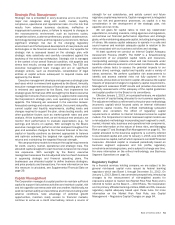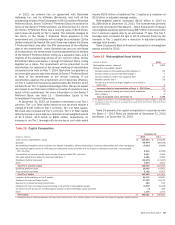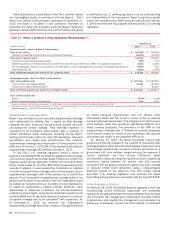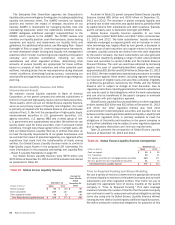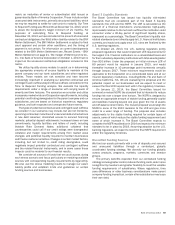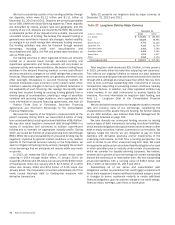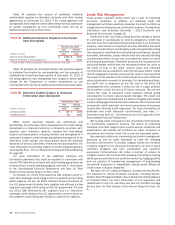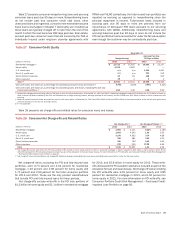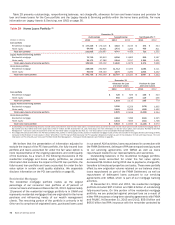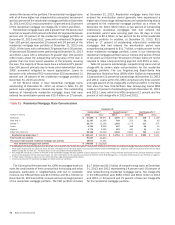Bank of America 2013 Annual Report Download - page 71
Download and view the complete annual report
Please find page 71 of the 2013 Bank of America annual report below. You can navigate through the pages in the report by either clicking on the pages listed below, or by using the keyword search tool below to find specific information within the annual report.Bank of America 2013 69
metric as maturities of senior or subordinated debt issued or
guaranteed by Bank of America Corporation. These include certain
unsecured debt instruments, primarily structured liabilities, which
we may be required to settle for cash prior to maturity. Our Time
to Required Funding was 38 months at December 31, 2013, which
is above the Corporation’s target minimum of 21 months. For
purposes of calculating Time to Required Funding, at
December 31, 2013, we have included in the amount of unsecured
contractual obligations the $8.6 billion liability related to the BNY
Mellon Settlement. The BNY Mellon Settlement is subject to final
court approval and certain other conditions, and the timing of
payment is not certain. For information on current developments
related to the BNY Mellon Settlement see, Recent Events – BNY
Mellon Settlement on page 21. The merger of Merrill Lynch & Co.,
Inc. into Bank of America Corporation on October 1, 2013 had no
impact on the unsecured contractual obligations included in this
metric.
We utilize liquidity stress models to assist us in determining
the appropriate amounts of excess liquidity to maintain at the
parent company and our bank subsidiaries and other regulated
entities. These models are risk sensitive and have become
increasingly important in analyzing our potential contractual and
contingent cash outflows beyond those outflows considered in the
Time to Required Funding analysis. We evaluate the liquidity
requirements under a range of scenarios with varying levels of
severity and time horizons. The scenarios we consider and utilize
incorporate market-wide and Corporation-specific events, including
potential credit rating downgrades for the parent company and our
subsidiaries, and are based on historical experience, regulatory
guidance, and both expected and unexpected future events.
The types of potential contractual and contingent cash outflows
we consider in our scenarios may include, but are not limited to,
upcoming contractual maturities of unsecured debt and reductions
in new debt issuance; diminished access to secured financing
markets; potential deposit withdrawals; increased draws on loan
commitments, liquidity facilities and letters of credit, including
Variable Rate Demand Notes; additional collateral that
counterparties could call if our credit ratings were downgraded;
collateral and margin requirements arising from market value
changes; and potential liquidity required to maintain businesses
and finance customer activities. Changes in certain market factors,
including, but not limited to, credit rating downgrades, could
negatively impact potential contractual and contingent outflows
and the related financial instruments, and in some cases these
impacts could be material to our financial results.
We consider all sources of funds that we could access during
each stress scenario and focus particularly on matching available
sources with corresponding liquidity requirements by legal entity.
We also use the stress modeling results to manage our asset-
liability profile and establish limits and guidelines on certain
funding sources and businesses.
Basel 3 Liquidity Standards
The Basel Committee has issued two liquidity risk-related
standards that are considered part of the Basel 3 liquidity
standards: the LCR and the NSFR. The LCR is calculated as the
amount of a financial institution’s unencumbered, high-quality,
liquid assets relative to the net cash outflows the institution could
encounter under a 30-day period of significant liquidity stress,
expressed as a percentage. The Basel Committee’s liquidity risk-
related standards do not directly apply to U.S. financial institutions
currently, and would only apply once U.S. rules are finalized by the
U.S. banking regulators.
On October 24, 2013, the U.S. banking regulators jointly
proposed regulations that would implement LCR requirements for
the largest U.S. financial institutions on a consolidated basis and
for their subsidiary depository institutions with total assets greater
than $10 billion. Under the proposal, an initial minimum LCR of
80 percent would be required in January 2015, and would
thereafter increase in 10 percentage point increments annually
through January 2017. These minimum requirements would be
applicable to the Corporation on a consolidated basis and at our
insured depository institutions, including BANA, FIA and Bank of
America California, N.A. We are evaluating the proposal and the
potential impact on our businesses and we expect to meet or
exceed the final LCR requirement within the regulatory timelines.
On January 12, 2014, the Basel Committee issued for
comment a revised NSFR, the standard that is intended to reduce
funding risk over a longer time horizon. The NSFR is designed to
ensure an appropriate amount of stable funding, generally capital
and liabilities maturing beyond one year, given the mix of assets
and off-balance sheet items. The revised proposal would align the
NSFR to some of the 2013 revisions to the LCR and give more
credit to a wider range of funding. The proposal also includes
adjustments to the stable funding required for certain types of
assets, some of which reduce the stable funding requirement and
some of which increase it. The Basel Committee expects to
complete the NSFR recalibration in 2014 and expects the minimum
standard to be in place by 2018. Assuming adoption by the U.S.
banking regulators, we expect to meet the final NSFR requirement
within the regulatory timelines.
Diversified Funding Sources
We fund our assets primarily with a mix of deposits and secured
and unsecured liabilities through a centralized, globally
coordinated funding strategy. We diversify our funding globally
across products, programs, markets, currencies and investor
groups.
The primary benefits expected from our centralized funding
strategy include greater control, reduced funding costs, wider name
recognition by investors and greater flexibility to meet the variable
funding requirements of subsidiaries. Where regulations, time
zone differences or other business considerations make parent
company funding impractical, certain other subsidiaries may issue
their own debt.




